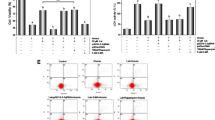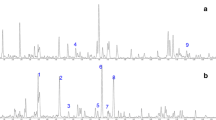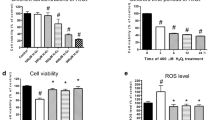Abstract
Ginsenoside Rg1 promotes antioxidative protection and intracellular calcium homeostasis in cardiomyocytes hypoxia/reoxygenation (H/R) model. However, the pharmacological effects of G-Rg1 on autophagy in cardiomyocytes have not been reported. In this study, we employed H9c2 cardiomyocytes as a model to investigate the effects of G-Rg1 on autophagy in cardiomyocytes under H/R stress. Our results showed that H/R induced increased level of LC3B-2, an autophagy marker, in a time-dependent manner in association with decreased cell viability and cellular ATP content. H/R-induced autophagy and apoptosis were further confirmed by morphological examination. 100 μmol/l Rg1-inhibited H/R induced autophagy and apoptosis, and this was associated with the increase of cellular ATP content and the relief of oxidative stress in the cells. Mechanistically, we found that Rg1 inhibited the activation of AMPKα, promoted the activation of mTOR, and decreased the levels of LC3B-2 and Beclin-1. In conclusion, our data suggest that H/R induces autophagy in H9c2 cells leading to cell injury. Rg1 inhibits autophagosomal formation and apoptosis in the cells, which may be beneficial to the survival of cardiomyocytes under H/R.






Similar content being viewed by others
References
Lü JM, Yao Q, Chen C (2009) Ginseng compounds: an update on their molecular mechanisms and medical applications. Curr Vasc Pharmacol 7:293–302
Zhou W, Chai H, Lin PH (2004) Molecular mechanisms and clinical applications of ginseng root for cardiovascular disease. Med Sci Monit 10:187–192
Gillis CN (1997) Panax ginseng pharmacology: a nitric oxide link? Biochem Pharmacol 54:1–8
Zhu D, Wu L, Li CR (2009) Ginsenoside Rg1 protects rat cardiomyocyte from hypoxia/reoxygenation oxidative injury via antioxidant and intracellular calcium homeostasis. J Cell Biochem 108:117–124
Cuervo AM (2004) Autophagy: many paths to the same end. Mol Cell Biochem 263(1–2):55–72
Kabeya Y, Mizushima N, Ueno T (2000) LC3, a mammalian homologue of yeast Apg8p, is localized in autophagosome membranes after processing. EMBO J 19:5720–5728
Matsui Y, Takagi H, Qu XP (2007) Distinct roles of autophagy in the heart during ischemia and reperfusion : roles of AMP-activated protein kinase and Beclin-1 in mediating autophagy. Circ Res 100:914–922
Decker RS, Wildenthal K (1980) Lysosomal alterations in hypoxic and reoxygenated hearts. I. Ultrastructural and cytochemical changes. Am J Pathol 98:425–444
Hamacher-Brady A, Brady NR, Gottlieb RA (2006) The interplay between pro-death and pro-survival signaling pathways in myocardial ischemia/reperfusion injury: apoptosis meets autophagy. Cardiovasc Drugs Ther 20:445–462
Gustafsson AB, Gottlieb RA (2008) Eat your heart out: role of autophagy in myocardial ischemia/reperfusion. Autophagy 4:416–421
Wagner C, Tillack D, Simonis G (2010) Ischemic post-conditioning reduces infarct size of the in vivo rat heart: role of PI3-K, mTOR, GSK-3beta, and apoptosis. Mol Cell Biochem 339(1–2):135–147
Gwinn DM, Shackelford DB, Egan DF (2008) AMPK phosphorylation of raptor mediates a metabolic checkpoint. Mol Cell 30:214–226
Gottlieb RA, Mentzer RM (2010) Autophagy during cardiac stress: joys and frustrations of autophagy. Annu Rev Physiol 72:45–59
Whelan RS, Kaplinskiy V, Kitsis RN (2010) Cell death in the pathogenesis of heart disease: mechanisms and significance. Annu Rev Physiol 72:19–44
Dorn GW 2nd (2009) Apoptotic and non-apoptotic programmed cardiomyocyte death in ventricular remodeling. Cardiovasc Res 81:465–473
Valentim L, Laurence KM, Townsend PA (2006) Urocortin inhibits Beclin1-mediated autophagic cell death in cardiac myocytes exposed to ischaemia/reperfusion injury. J Mol Cell Cardiol 40:846–852
Kiffin R, Christian C, Knecht E (2004) Activation of chaperone-mediated autophagy during oxidative stress. Mol Biol Cell 15:4829–4840
Yu L, Wan F, Dutta S (2006) Autophagic programmed cell death by selective catalase degradation. Proc Natl Acad Sci USA 103:4952–4957
Hardie DG (2007) AMP-activated/SNF1 protein kinases: conserved guardians of cellular energy. Nat Rev Mol Cell Biol 8:774–785
Laderoute KR, Amin K, Calaoagan JM (2006) 50-AMP-activated protein kinase (AMPK) is induced by low-oxygen and glucose deprivation conditions found in solid-tumor microenvironments. Mol Cell Biol 26:5336–5347
Hamacher-Brady A, Brady NR, Gottlieb RA (2006) Enhancing macroautophagy protects against ischemia/reperfusion injury in cardiac myocytes. J Biol Chem 281:29776–29787
Aki T, Yamaguchi K, Fujimiya T (2003) Phosphoinositide 3-kinase accelerates autophagic cell death during glucose deprivation in the rat cardiomyocyte-derived cell line H9c2. Oncogene 22:8529–8535
Acknowledgment
This work was supported by National Science and Technology Major Projects for “Major New Drugs Innovation and Development” (No. 2009ZX09103-441).
Author information
Authors and Affiliations
Corresponding author
Rights and permissions
About this article
Cite this article
Zhang, ZL., Fan, Y. & Liu, ML. Ginsenoside Rg1 inhibits autophagy in H9c2 cardiomyocytes exposed to hypoxia/reoxygenation. Mol Cell Biochem 365, 243–250 (2012). https://doi.org/10.1007/s11010-012-1265-3
Received:
Accepted:
Published:
Issue Date:
DOI: https://doi.org/10.1007/s11010-012-1265-3




